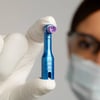Each week, Young Innovations hosts a free CE course for dental hygienists, covering a variety of topics taught by clinicians from all walks of the profession. Whether you missed the live webinar or were able to attend, these course notes are intended to support clinicians with quick, digestible takeaways from our CE courses.
When it comes to slow-speed handpiece and polishing paste choices, there are many factors for hygienists to consider. How do you determine what's best?
When considering a slow-speed handpiece, the quality, cost and ergonomics are important factors when making purchase decisions.
Selection of polishing/prophy pastes is an equally important decision for clinicians. The paste choices we make for our patients should be based on grit, ingredients and proven clinical results.
Here are a few things to consider when it comes to handpiece and paste selection.
Selective Polishing
Selective polishing is defined as polishing only the tooth surfaces that have visible stains after scaling and oral debridement or using different grades of pates for stained and unstained surfaces.
Therapeutic Paste Benefits
Therapeutic benefits of paste include removal of biofilm and stains.
Contraindications to Polishing Include:
- acute gingival or periodontal inflammation
- decalcification
- newly erupted teeth
- patients with respiratory problems
- allergies to ingredients in paste
- recession and exposed dentin or cementum
For a comprehensive list, check out an article by Claire Jeong, MS, RDH: Coronal polishing: Indications and contraindications for dental assistants | DentistryIQ
Paste Ingredients
Pastes may be gluten free, fluoride free, dye free or even pumice free. There are also pastes that are powered by baking soda, contain ACP (amorphous calcium phosphate) and are implant-friendly. Check out Young's variety of paste and cleaning agent options.
Hygiene Handpieces
Take sterilization and disinfection into account when selecting a hygiene handpiece. Properly processing your handpiece is critical, and if you don't plan ahead, it could affect your schedule. Some handpiece systems allow you to process certain components more easily between patients, while others require you to use multiple handpieces to allow for enough processing time between patients.
Processing Corded Handpieces
The Centers for Disease Control and Prevention recommend corded handpieces be sterilized between each patient, including the nosecone and motor. Depending on how much time you have between patients, you may need extra corded handpieces to cover your patient load.
Processing Cordless Handpieces
Always follow the manufacturer instructions for use when disinfecting and sterilizing cordless handpieces. For the Young Infinity Cordless Hygiene Handpiece, only the nosecone should be sterilized. All other components are disinfected with an EPA-approved disinfectant. With extra nosecones, one handpiece can service your op.
For other useful Course Notes recaps, visit the Continuing Education section of our blog.




Submit a Comment